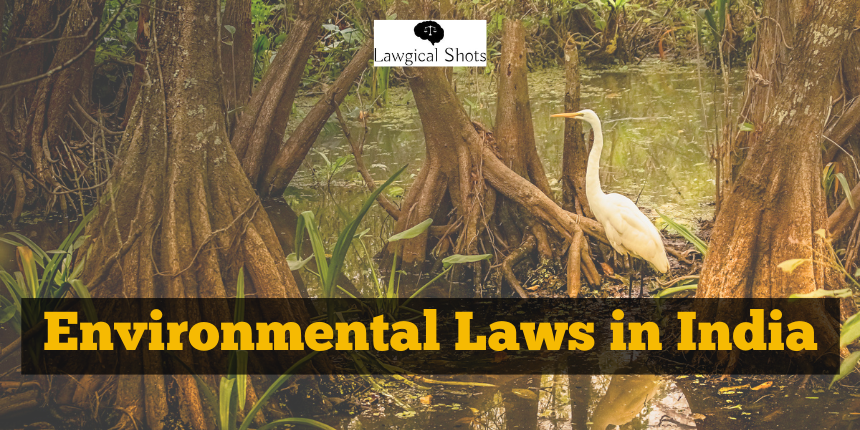We have one earth, and we humans failed to take care of the nature’s gift. The rivers are polluted, air is comparable to gas chamber in some places, some animals are at the verge of extinction, and humans are also facing several health issues. We have some environmental laws in India which target a particular aspect, one or the other way promoting the protection of environment. Our intern, Advocate Aakash Poddar brings in your chance to catch up with the several laws for environment protection in India.
Environmental Laws in India

1. The Wild Life Protection Act, 1972
This Act has been enacted for the protection of wildlife habitat and biodiversity in India. It also provides legal support for wildlife protection and control of the illegal Hunting of animals. In this Act, some amendments have been made based on need of the hour. In the 1986 amendment, this Act enhanced the penalty provisions in the Act and also expanded the definition of wildlife. In the 1991 Amendment to Wild Life Protection Act, penalty was increased. Whereas in 2002 Amendment Act, the law became more stringent for the wildlife protection compliances. In 2006 Amendment, protection of biodiversity was introduced in this Act. Thus, we can say that this Act is one of the foundational legislations in India for the Environment protection. This Act introduced the legal framework to conserve the species and protect the habitants and provide ecological balance in the country.
2. The Water Prevention and Control of Pollution Act, 1974
This Act has been enacted for the prevention and control of water pollution and to maintain the wholesomeness of water in the country.
It also provides for establishment of the Board for the Prevention and Control of Water Pollution with a view to carry out the aforesaid purpose. The Water Act always prohibits the discharge of pollutants into water bodies beyond a given standard and laid down the penalties for the non-compliance of the rules and regulations under water Act. At the Central level, the water Act has been under the aegis of the Central Pollution Control Board which lays down the standards for the prevention and control of water pollution. On the other hand, if we talk about the State level, the State Pollution Control Board is responsible for prevention and control of water pollution. This Act also provides for the levy and collection of cess on water consumed by persons operating and carrying on different types of industrial activities in the economy.
3. The Air Prevention and Control of Pollution Act, 1981
This Act aims to provide for the prevention, control and abatement of air pollution and for the establishment of the Pollution Control Boards at the Central as well as State levels with a view to carrying out the aforesaid purposes.
This aAt also empowers the State Government to declare any areas within the state as air pollution control areas. State pollution control boards test the air pollution and inspect pollution control equipments and manufacturing processes.
4. The Environment Protection Act, 1986
This Act provides for the protection and improvement of the environment because as per the DPSP under Constitution of India Article 48A, protection and improvement of environment and safeguards of forest and wildlife. This Article says that “The state shall endeavour to protect and improve the environment and to safeguard the forest and wild life of the country”. This is an umbrella legislation which also provides the framework for the coordination among Central as well as State authorities. The term Environment is defined under this act and “includes water, air and land as well as the interrelationship which exists between water, air and land, human beings and other living creatures, plants, microorganism and property”. If any contravention of this Act arises, then the violator will be punishable with imprisonment up to 5 years or fine up to Rs. 1,00,000 or with both. IF continued, then it will be increased to an additional fine up to Rs. 5,000 every day during such contravention fails.
5. The Ozone-Depleting substances Regulation and Control Rules, 2000
The main aim of Ozone-Depleting substances Regulation and Control Rules, 2000 is to reduce the ozone depleting substances in India. This also includes monitoring of the import-export and use of ozone depleting substances. The government grants the license and certifications for entities involved in the import and trade of the substances.
6. Energy Conservation Act, 2001
This Act plays a significant role in the Environment related legislations. The main aim of this Act is to promote energy, efficiency and conservation of various sectors. This Act also provides for the development of energy conservation building code which is set out in the commercial buildings with minimum energy. It also helps in creating a friendly building environment. The objective is to promote energy efficiency and reduce carbon footprint and also improve the energy security in the economy.
7. Biodiversity Act, 2002
Formerly, this Act was named as Biological Diversity Act, 2002. It is an important law for preserving the biological resources of the country. This Act stipulates the offences which are cognizable and non bailable in terms of conservation of biodiversity at national, state and local levels. It is the Regulation which assesses the biological resources and regulates the resources in proper manner. The main purpose of this Act is to keep away from the exploited resources in the plants, animals and living creatures. Thus, we can say that it was a comprehensive law and it’s a key environment laws which protect the biodiversity and environment in the country.
8. Scheduled Tribes and other Traditional Forest Dwellers Recognition of Forest Rights Act, 2006
This Act, is commonly called ‘The Tribal Rights Act or the Tribal Land Act’, or the Forest Rights Act 2006. It was enacted in India to recognise forest rights vested in Schedule Tribes and other traditional forest dwellers. The main objective of this Act is to recognise the forest rights and promote the conservation of forests in India.
9. The National Green Tribunal Act, 2010.
This Act was established in the year 2010. Influenced by the Rio Conference of 1992, it was based on the international environment principles of polluter pays principle and Sustainable Development. The Act led to establishment of the National Green Tribunal which deals in civil cases only, not the criminal cases. The orders of NGT are not bound to follow the procedural law under the Civil Procedure Code, 1908. The headquarters of NGT is in Delhi, Bhopal, Pune, Kolkata and Chennai. The main aim of NGT is to enforce the legal rights relating to the environment and give relief to the persons and property for matters connected thereto. NGT also does not follow the Evidence laws in a strict sense, the newly enacted Bharatiya Sakshya Adhiniyam.
10. Compensatory Afforestation Fund Act, 2016.
This Act contains 6 chapters and has 33 sections. The main aim of this Act is to provide for the establishment of funds for each State for environmental purposes. The Act also focuses on receiving of the money from the users or agencies towards compensatory afforestation. Sections 3 and 4 of the Act provides for the Funds. It shall be the duty of the government to make these funds at the State as well as Central levels. In this Act, the funds can be used only for the treatment of catchment areas, forest management and wildlife protection management. Thus, we can say that it is one of the important Acts for giving the protection of the Environment laws.








